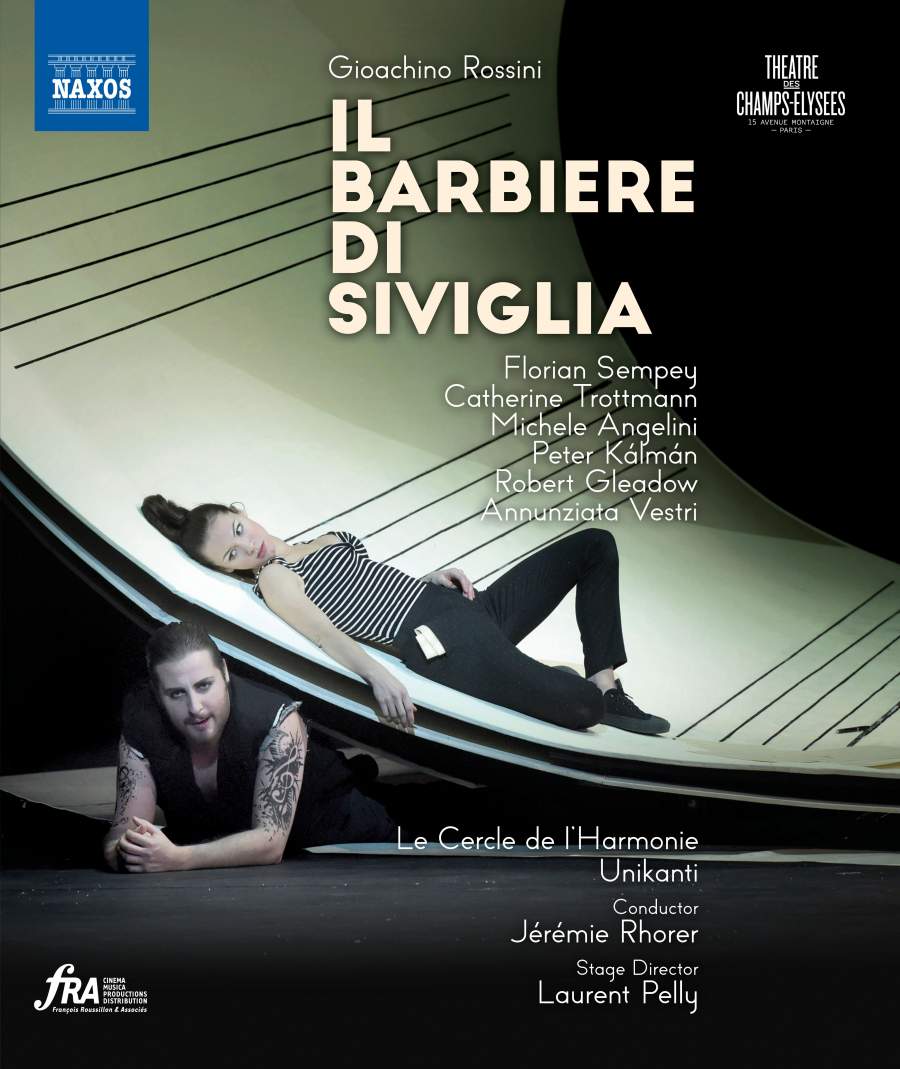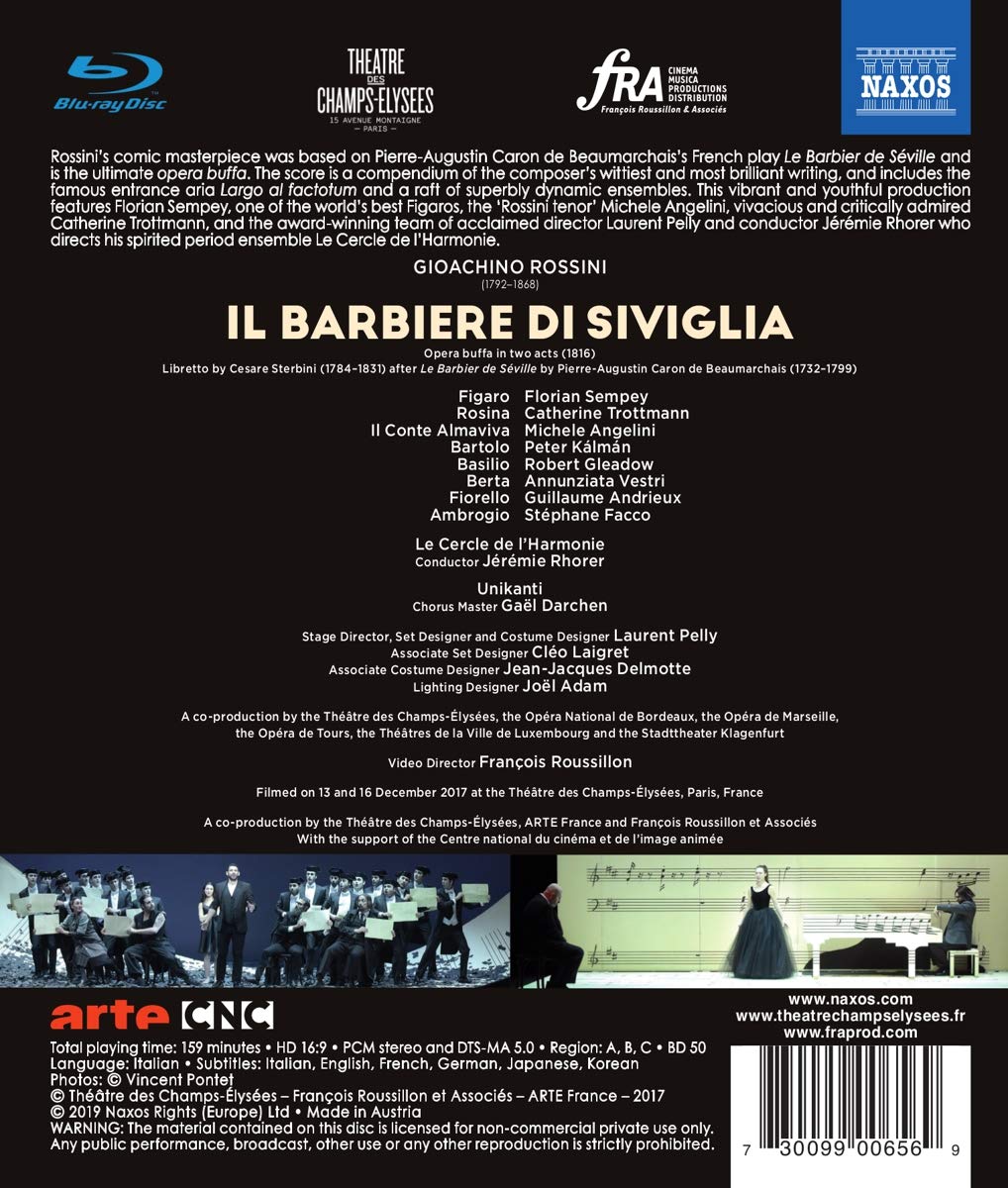

Rossini Il barbiere di Siviglia opera to libretto by Cesare Sterbini. Directed 2017 by Laurent Pelly at the Théâtre des Champs Elysées in Paris. Stars Florian Sempey (Figaro) Catherine Trottmann (Rosina), Michele Angelini (Il Conte Almaviva), Peter Kálmán (Bartolo), Robert Gleadow (Basilio), Annunziata Vestri (Berta), Guillaume Andrieux (Fiorello), and Stéphane Facco (Ambrogio). Jérémie Rhorer conducts Le Cercle de l’Harmonie and Unikanti (Chorus Master Gaël Darchen). Set and costume design by Laurent Pelly; associate set designer was Cléo Laigret; associate costume designer was Jean-Jacques Delmotte; lighting design by Joël Adam. Directed for TV by François Roussillon; executive producer was George Bruell. Sung in Italian. Released 2019, disc has 5.1 dts-HD Master Audio sound. Grade: A+
A great opera production requires excellence in all elements of the work: the orchestral music, singing, stage direction and movements, acting, sets, costumes, and props, etc. Each element needs to be coordinated to the overall concept of the conductor of the orchestra and the stage director. If everything is properly related, you can be successful with almost any “style” you dream up. Then you can also have a great video if you start working with the videographer early in the preparation of the show. Subject title is a good proof of these statements with its clean, modern presentation of Rossini’s early and most popular bel canto opera, Il barbiere di Siviglia.
Our 1st screenshot is a most unusual view where videographer Roussillon shows us the pit orchestra with our lover Count Almaviva (Michele Angelini) singing solo in Act 1. As time goes by, it seems the period-instrument orchestras are sounding better than ever. Or could it be I’m just getting used to the them? Either way, Le Cercle de I’Harmonie under Jérémie Rhorer sounds fabulously bright, clear, and rich and is wonderfully recorded. So it’s appropriate for the video to show us some of the orchestra during the stage performance. From this shot we also see that the costumes and stage designs are modern with no attempt to transport us to the 18th century. We are being treated to an opera, not a history lesson:
I think Rossini has always been considered the greatest composer of opera overtures. So during this sinfonia, Roussillon shows us the orchestra:
Next below we meet Figaro, a barber in Seville (Florian Sempey). In those days, the barber was also a surgeon and a handy man. Nice subtitles in English:
Here we see the opening scene with the Count, disguised as a poor student, trying to woo the mysterious beauty Rosina (Catherine Trottmann) with a serenade. What a beautiful depiction of a balcony!
A close-up of Trottmann, an earthly mezzo oozing with sex appeal:
But alas, she’s dominated by her grumpy, lecherous guardian, Dr. Bartolo (Peter Kálmán):
Figaro and the Count are old buddies, and Figaro explains Rosina’s predicament with her ardent guardian. Note Figaro’s exquisite tattoos including the portrait of Rossini. Nobody in the audience can see this. This is the kind of attention to detail you get with the videographer is part of the production team from the outset:
Rosina may be in a pickle, but she is not without resources:
This is a comedy, but the first of only 4 arias belongs to Basilio (Robert Gleadow) the music teacher and hypocrite. Bartolo thinks the real Count Almaviva may come to town to seek Rosina. Basilio, in a funny but also frightening discourse on “slander”, suggests that Bortolo can run off the Count by starting a whisper campaign against him:
The prospect of playing such a dangerous game with a Count leaves Bartolo distraught in this close-up probably recommended by Roussillon for the home viewers:
Almaviva, at the Figaro, seeks access to Rosina by changing his disguise to that of a soldier with a billeting order saying he should make his quarters in Bartolo’s house. This leads to typical comic opera chaos when Almaviva pretends he is staggeringly drunk. Basilio and housekeeper Berta (Annunziata Vestri) try to protect Rosina while Bartolo seeks safety trying to hide behind his ward!
The cops arrive to quiet the neighborhood. They are members of the Unikanti chorus carrying music stands as weapons:
From the Act 1 finale:
Act II opens with the music lesson scene. Almaviva, disguised as Lindoro has changed his disguise to that of Basilio’s assistant music teacher (looks much like his master). Stating falsely that Basilio is ill, Almaviva finally gets into Bartolo’s house. He plays the piano for Rosina’s recital piece. Bartolo, exhausted by recent riotous events, goes to sleep on his ward:
The plot thickens yet more when Basilio turns up and is astonished to encounter his alleged assistant. Almaviva as the bogus assistant tries to convince Basilio that he is in fact ill:
Figaro is exasperated by the mounting confusion, but his empty purse requires that Bartolo get his regular shave:
Seeing all the excitement of the men surrounding Rosina, Berta is inspired to seek some action also:
The ever-calm Rosina shows her masterly of the use of case in English pronouns:
And as the union of Rosina and her Lindoro (uh, Almaviva) nears, Berta gets back in the hunt herself with Basilio:
When Basilio can’t quit crying, Berta tries her luck with Figaro:
But Figaro isn’t interested in romance. He probably has some gambling debts coming due this evening:
Richard Osborne gave this perhaps the most enthusiastic print review I’ve ever read. See the December 2019 Gramophone at pages 119-120, where Osborne calls this disc a “pitch-perfect telecast of Pelly’s own pitch-perfect staging” with “wonderful” acting and music, all leading to his final exclamation, “My, what skills are on display in every department of this astonishing production!” My screenshots really can’t show why Osborne was so impressed. But when you see all the elements of this production relate so well to each other in your HT, you may be astonished too. Glade A+
Here’s a clip from Naxos:
OR























